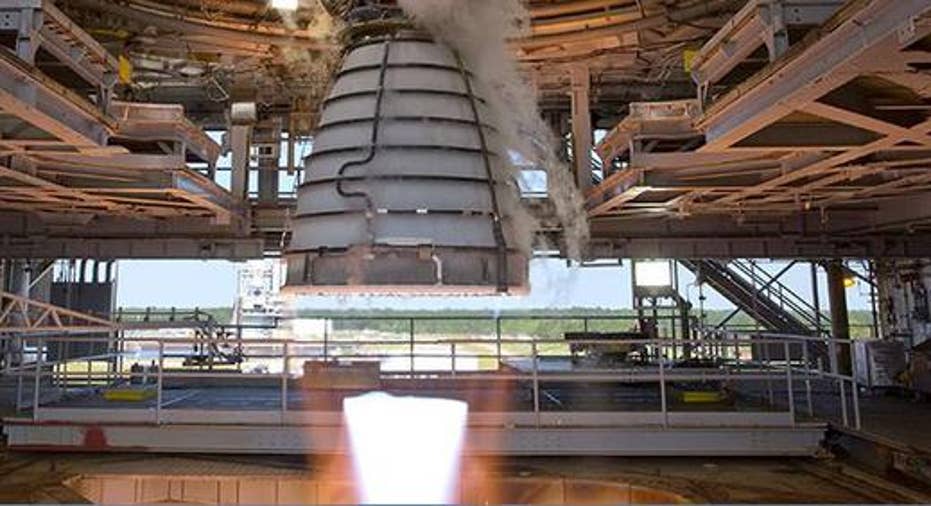With 2 Big Rocket Contracts, America Is Racing Back to Space

America is building a new space rocket -- and Russia is out of luck.
Lockheed Martin's Vulcan rocket is the sum of many parts. Blue Origin's engine could be one of them. Image source: United Launch Alliance.
That was the big news last year, when Lockheed Martin announced it is moving ahead with plans to "expand production capabilities for the American-made BE-4 engine that will power the Vulcan next-generation launch system."
The rocket engine in question, Blue Origin's BE-4, is "a liquid oxygen, liquefied natural gas (LNG) rocket engine that delivers 550,000-lbf of thrust at sea level." According to Blue Origin, "Two BE-4s would power each ULA Vulcan booster, providing 1,100,000-lbf thrust at liftoff." Blue Origin is specifically developing the rocket for United Launch Alliance -- the joint venture between Lockheed Martin and Boeing -- to use to power its next-generation Vulcan launch vehicle. Once operational, the new engine will relieve ULA of the need to buy RD-180 engines from Russiato power its rockets.
Clearly, Lockheed Martin likes the BE-4 engine a lot, throwing its support behind Blue Origin's product in preference to the alternate AR1 engine being developed by Aerojet Rocketdyne . But here's a real revelation for you: The U.S. Air Force seems to like the BE-4 engine, too.
Last week, in its daily digest of contracts awarded to Pentagon suppliers, the U.S. Department of Defense announced it has awarded ULA $46.6 million in funding for development of what it's already calling "the Vulcan BE-4."
Key stats on Blue Origin's engine. Image source: United Launch Alliance.
What it means to Boeing and Lockheed Martin investors... Now, $46.6 million won't come close to covering the whole bill for developing Blue Origin's engine. Rather, the Pentagon says the funds are intended to "leverage" the "investment" Blue Origin and ULA are already making in the engine. But if the Air Force can chip in a few bucks, and goose the production schedule a bit -- so as to avoid the political embarrassment of ULA having to go back, hat in hand, begging Russia for more RD-180 engines -- that's apparently worth a measly $46.6 million.
Shareholders of Boeing and Lockheed Martin certainly won't turn down the money, which will reduce costs for the companies, and fatten their bottom lines.
...and what it means for Aerojet Rocketdyne On the other hand, this would seem to spell bad news for Aerojet Rocketdyne and the alternate engine it's been developing for the Vulcan -- except that it's not actually bad news at all. Simultaneous with the announcement of $46.6 million in funding for the BE-4 engine, the Pentagon announced it's awarding Aerojet Rocketdyne $115.3 million to help develop the AR1 engine.
What's perhaps even more interesting is that, after tallying up all the contributions the Pentagon is making to Aerojet's efforts, it turns out the Pentagon is paying $536 million toward the "shared cost" of developing AR1, whereas Aerojet is spending only $268 million! To make that even clearer, that's 2 taxpayer dollars being anted up for every $1 that Aerojet invests in an engine that Lockheed and Boeing probably won't even want.
(By the same yardstick, investments by Boeing and Lockheed in the BE-4 Vulcan project come to $134.2 million, says the Pentagon, versus the $201.6 million supplied by the Pentagon. That's closer to a $1.50-to-$1 public-private partnership on Lockheed's preferred engine.)
It's curious how the Pentagon has decided to lend (much) more support to Aerojet's disfavored engine, in preference to Blue Origin's offering, which Lockheed clearly prefers. Regardless, the general upshot for investors is this:
Both ULA and Aerojet are racing to put America back in space. But it's taxpayers providing the fuel -- and shareholders who will reap the benefits.
Aerojet Rocketdyne says its AR1 engine offers the "lowest cost to the taxpayer." So why is the Pentagon spending four times more on its development than on Blue Origin's BE-4 engine? Image source: Aerojet Rocketdyne.
The article With 2 Big Rocket Contracts, America Is Racing Back to Space originally appeared on Fool.com.
Rich Smithdoes not own shares of, nor is he short, any company named above. You can find him onMotley Fool CAPS, publicly pontificating under the handleTMFDitty, where he's currently ranked No. 270 out of more than 75,000 rated members. Follow him on Facebook for defense news.The Motley Fool has no position in any of the stocks mentioned. Try any of our Foolish newsletter services free for 30 days. We Fools may not all hold the same opinions, but we all believe that considering a diverse range of insights makes us better investors. The Motley Fool has a disclosure policy.
Copyright 1995 - 2016 The Motley Fool, LLC. All rights reserved. The Motley Fool has a disclosure policy.